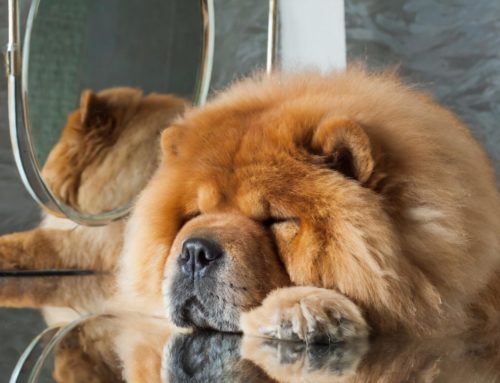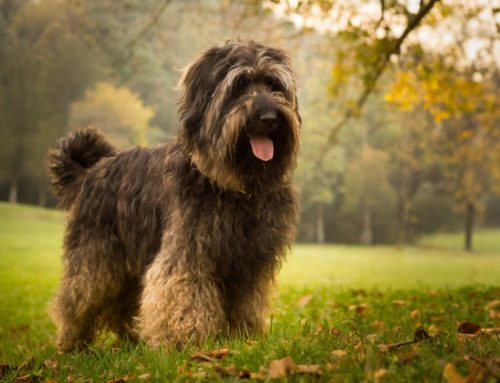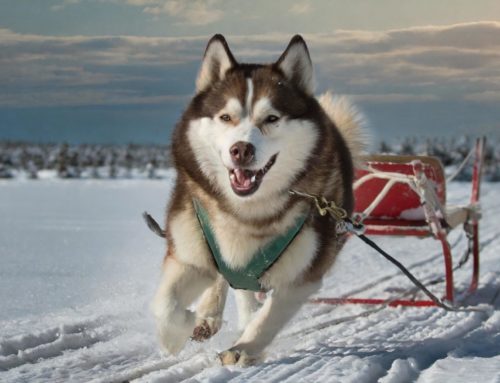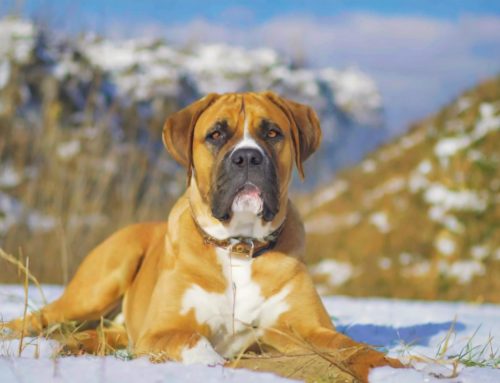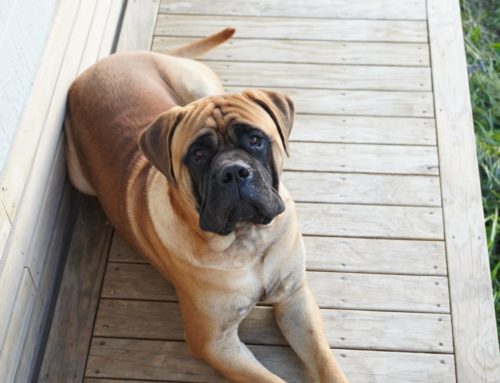
The Bedlington Terrier, a unique and charming dog breed, originated in the mining areas of Northumberland, England, and more specifically in the town of Rothbury. This breed was originally called “Rothbury Terrier” and developed into the Bedlington Terrier as we know it today in the 1800s.
These terriers were bred for hunting badgers and other vermin, thanks to their energetic and courageous nature. A characteristic feature of the Bedlington Terrier is its soft, silky coat that is often compared to that of a lamb.
This coat can be either blue and tan or liver- or sand-coloured and requires regular brushing and trimming to prevent tangles. Bedlington Terriers usually weigh between 8 and 10 kg and are known for their graceful, lithe build, with muscular hind legs and ears that are low set and velvety to the touch.
FCI group 3 terriers
A striking appearance, the Bedlington Terrier belongs to the FCI Group 3, along with other terrier breeds such as the Dandie Dinmont Terrier. The breed is known for its unique appearance and gentle nature.
The Bedlington resembles a lamb in appearance, with its bowed head, curly coat and slender build. Although they are small, they have strong loins and are agile. Their eyes are small and their ears flat against the cheek. Historically, Bedlingtons evolved from a mix of several breeds, including terriers and whippets.
They were originally bred for hunting vermin, such as rats and rabbits, because of their agility and speed. Nowadays, they are mostly known as charming companion dogs.
Coat and appearance of the Bedlington Terrier
The Bedlington Terrier is a distinctive dog breed known for its unique appearance. This small dog, often compared to a lamb, has a distinctive coat that is soft and curly.
The Bedlington’s coat can range from colours such as wheaten (wheat-coloured), blue, or liver (liver-coloured), and requires regular brushing and trimming by a professional groomer to prevent tangles and maintain its distinctive look. The Bedlington Terrier is strong and muscular with a graceful build somewhat reminiscent of a Whippet.
Their ears are low set and velvety to the touch, covered in fine hairs. These terriers have small, lighter eyes that enhance their intelligent and alert expression.
Breeders and clubs such as the Bedlington Terrier Club stress the importance of responsible breeding practices, especially as the breed can be prone to hereditary conditions such as copper stacking disease.
Hereditary diseases and disorders
The Bedlington Terrier, although generally a robust and healthy breed, can be susceptible to some inherited diseases and disorders.
Here is a list of some of the most common hereditary diseases in Bedlington Terriers:
- Copper Stacking Disease: A serious condition in which copper accumulates in the liver, which can lead to liver failure.
- Retinal Dysplasia: An eye condition that affects the retina and can lead to visual impairment or blindness.
- Renal Cortical Hypoplasia: A kidney problem in which the kidneys do not fully develop, which can lead to kidney failure.
- Patellaluxation: The sliding of the kneecap out of its normal position, which can cause pain and walking problems.
- Distichiasis: A condition in which extra eyelashes grow that can irritate the eye.
- Cardiomyopathy: A heart condition that affects the heart muscle and can lead to heart failure.
- Thrombopathy: A blood clotting disorder that can lead to excessive bleeding from injuries.
The character of the Bedlington Terrier ( puppy )
The Bedlington Terrier, with its distinctive appearance sometimes reminiscent of a lamb, is a unique breed of terrier. These dogs are intelligent and lively, with a friendly and affectionate nature. As puppies, they quickly exhibit their playful and curious nature.
They are known to be excellent playmates for children, partly due to their energetic and gentle temperament. Like almost all terriers, the Bedlington has a certain amount of stubbornness and independence. They were originally bred by miners for hunting small animals, so they have a natural hunting instinct.
This breed is intelligent and eager to learn, which makes them suitable for various dog sports and activities. The Bedlington Terrier gets along well with other pets, including cats, provided they are introduced together from an early age. Their ears are velvety to the touch and covered in fine hairs, which contributes to their distinctive appearance.
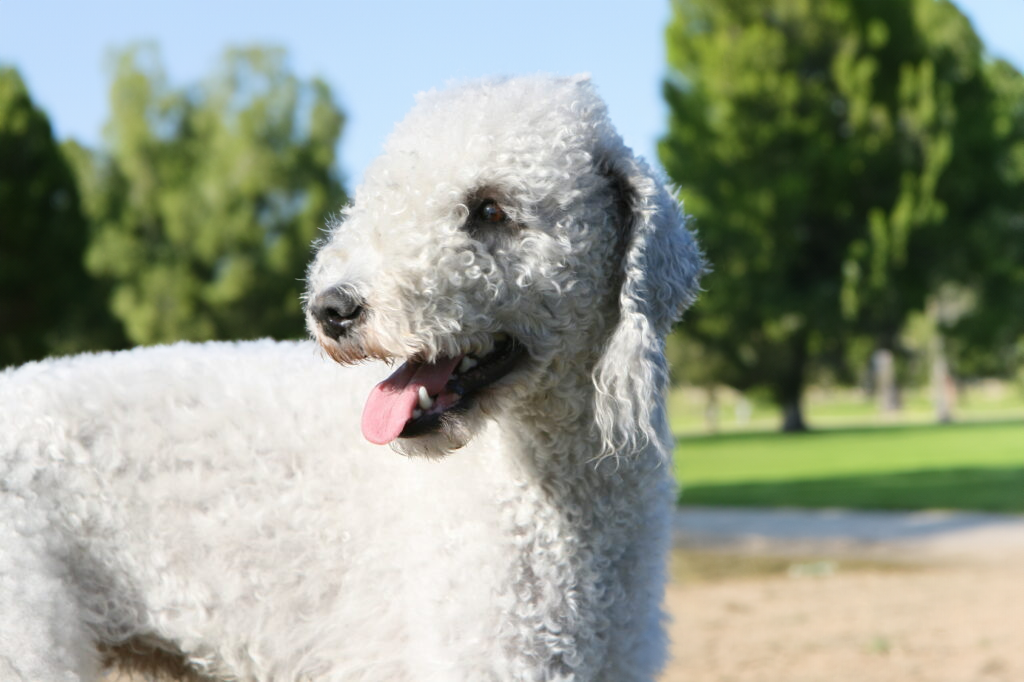
The Care of the Bedlington Terrier
The Bedlington Terrier, requires specific care to stay healthy and happy. Like all dogs, the Bedlington Terrier needs regular grooming, both in terms of physical care and exercise. The Bedlington Terrier’s coat is perhaps its most distinctive feature. This coat needs regular brushing and combing to prevent tangles and maintain its soft, woolly texture.
As with other terrier breeds, such as the West Highland White Terrier and the Soft Coated Wheaten Terrier, the Bedlington’s coat requires professional trims to maintain its distinctive look.
Besides coat care, Bedlingtons also need plenty of exercise. They are energetic and intelligent dogs that love to play in the house and garden. Regular walks and play sessions are essential to meet their physical needs.
Socialisation and upbringing of the Bedlington Terrier
The socialisation and upbringing of a Bedlington Terrier are essential for its development into a well-adjusted and happy dog. From the moment the puppy comes home, it is important to get him used to different people, situations and other pets.
Originally a cross between breeds such as the Kerry Blue Terrier and Otterhound, the Bedlington Terrier has a friendly and adaptable nature that responds well to socialisation.
These dogs love to be the centre of attention and need a considerable amount of exercise to stay healthy and happy. Their muscular build and energetic temperament require daily walks and playtime. It is essential for the Bedlington to receive sufficient physical and mental challenges.
Consistency is crucial when raising the Bedlington. These dogs are smart and can learn quickly, but they need clear and consistent guidelines. They are naturally inclined to please their owners, so positive reinforcement is very effective. When breeding Bedlingtons, reputable breeders emphasise both health and temperament.
How much experience does a Bedlington Terrier require
The Bedlington Terrier, with its unique appearance and charming personality, can suit both experienced and inexperienced dog owners, but with some considerations.
For inexperienced owners, the Bedlington can be a good choice because of its adaptable and generally easy-going temperament. They are known for their loving and affectionate nature, which makes them a great companion for beginners.
However, potential owners, regardless of their experience level, should be aware of the specific needs of this breed. The Bedlington Terrier requires regular grooming of its distinctive coat, which requires time and attention. Their energy level is moderate, but they do need daily exercise to stay healthy and happy.
For experienced dog owners, the Bedlington offers the opportunity to use their skills in dog training and grooming. These dogs respond well to both obedience training and activities that promote their mental stimulation. Experienced owners may be more responsive to the subtle behavioural characteristics and needs of this breed.
Is training necessary?
Training is an essential part of caring for a Bedlington Terrier. Despite their gentle and friendly nature, it is important to teach these intelligent dogs good manners and obedience from an early age. As with any dog breed, early and consistent training helps prevent behavioural problems and ensures a happy and well-adjusted dog.
The Bedlington Terrier is known for its eagerness to learn and desire to please its owners, which makes it highly trainable. They respond well to positive reinforcement techniques such as praise and treats. Training should focus on basic commands, potty training, and socialisation with people and other animals.
These dogs also benefit from mental stimulation. Activities such as obedience training, agility exercises and puzzle games help keep their minds sharp. Moreover, training can help strengthen the bond between the dog and its owner, building a trusting relationship that is essential for their overall well-being.
How much exercise does a Bedlington Terrier need?
Known for its energetic and playful nature, the Bedlington Terrier needs a moderate amount of exercise daily to stay healthy and happy. Originally bred for hunting, this breed has a natural need for physical activity and mental stimulation.
On average, a Bedlington Terrier needs about 30 to 60 minutes of exercise per day. This can be broken down into two or three shorter walks, supplemented by play time in a safe, fenced-in area. The Bedlington loves to run, play and explore, so activities that promote these instincts are ideal.
In addition to daily walks, Bedlingtons will also enjoy occasional games such as fetch, agility training, and other interactive games that challenge both their bodies and minds. This breed is intelligent and inquisitive, which means mental stimulation is just as important as physical activity.

How is it getting along with children?
The Bedlington Terrier is known for its friendly and gentle temperament, which makes it an excellent family dog, especially in homes with children.
These playful and loving dogs can make great playmates for children, provided there is mutual respect and understanding. Their patient and forgiving nature makes them suitable for interaction with children of all ages. However, when interacting with children, supervision is essential, especially with younger children.
This is to ensure the safety of both the child and the dog. Children should be taught how to treat the dog respectfully and gently, without teasing or overwhelming it. Bedlington Terriers are naturally energetic and will enjoy playtime and activities with children.
They can thrive in a family environment and usually adapt easily to household dynamics. Thanks to their intelligent and inquisitive nature, Bedlingtons are also easy to train, which helps establish clear boundaries and rules of behaviour within the family.
Advantages of a Bedlington Terrier
- Friendly and Loving: Bedlington Terriers are known for their gentle and affectionate nature, which makes them excellent companion dogs.
- Good with Children: Their patient and playful nature makes them suitable for families with children.
- Hypoallergenic: The Bedlington Terrier’s coat is almost hypoallergenic, making them a good option for people with allergies.
- Intelligent and Trainable: These dogs are intelligent and respond well to training, making them relatively easy to train.
Disadvantages of a Bedlington Terrier
- Regular Coat Care Needed: Their distinctive coat requires regular grooming and trimming.
- Exercise Needs: Bedlington Terriers need daily exercise to expend their energy.
- Potential Health Problems: They may be susceptible to certain hereditary health conditions, including copper staph disease.
- Hunting instinct: Their hunting instinct can be a challenge when dealing with smaller pets.
How old will a Bedlington Terrier get
The Bedlington Terrier, has an average life expectancy of about 12 to 14 years. However, this lifespan depends on several factors, including genetics, lifestyle and general health.
Price of a Bedlington Terrier
The Bedlington Terrier, distinctive for its “lamb-like” coat and lively disposition, is relatively rare in the US. Here’s an overview of what to anticipate in terms of cost, similar breeds, and further advice:
Price of a Bedlington Terrier Puppy in the US:
- Typical Range: Given their rarity, it’s hard to specify an exact price, but you can expect to spend between $1,200 and $2,000 for a puppy from a reputable breeder.
- Higher Range: Prices could be higher for puppies from exceptional bloodlines or those destined for the show ring.
Factors Influencing Price:
- Breeder Reputation: Expect higher prices for puppies from well-known breeders with champion lines.
- Pedigree: AKC-registered Bedlington Terriers tend to be pricier than those without papers.
- Location: Costs may be elevated in regions with a higher cost of living.
- Age: Generally, adult dogs are less expensive than puppies.
- Coat Color: Unusual colors like blue or liver may fetch a premium.
Breeds Similar to the Bedlington Terrier:
For those drawn to the Bedlington Terrier’s dynamic character, hypoallergenic coat, and spirited nature, consider these breeds:
- Whippet: Known for their sleek build and affable temperament, with a price range of $1,000 to $2,000. They possess short coats and require plenty of exercises.
- Scottish Terrier: An independent breed with a distinctive coat, available for around $800 to $1,500. Regular grooming is needed, though they’re not high shedders.
- Lakeland Terrier: Known for their agility and playful demeanor, priced similarly to the Bedlington, between $1,200 and $2,000. Their wiry coat needs regular maintenance.
Additional Guidance:
- In-depth Research: Bedlington Terriers are full of energy and need ongoing training and engagement. Confirm their exercise requirements and temperament suit your lifestyle.
- Visit the Breeder: Ensure you visit the breeding facility and meet the puppy’s parents to check for health and temperament.
- Prioritize Training: Intelligent and trainable, Bedlington Terriers benefit from early socialization and consistent training.
- Grooming Needs: Their distinctive coat requires regular upkeep and professional grooming to maintain its appearance.
Locating a Bedlington Terrier Breeder:
- Bedlington Terrier Club of America: Engage with established organizations for referrals to reputable breeders.
- Online Kennel Directories: Utilize kennel directories to find breeders in your region, ensuring you make direct inquiries about availability and costs.
Remember: Taking on the responsibility of a pet is a significant, long-term commitment. While purebred Bedlington Terriers may be less common in rescues, exploring adoption is a worthy consideration. You may discover breeds with similar qualities in shelters, often at a lower cost, ready to become a beloved part of your family.
